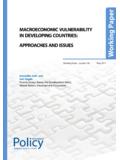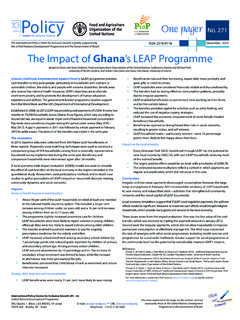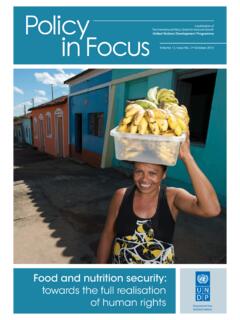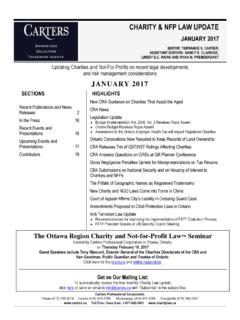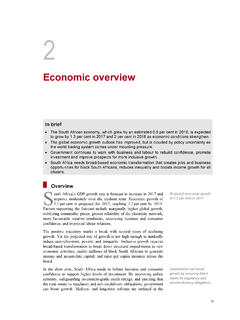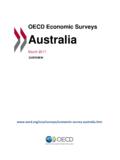Transcription of Overview of Non-contributory Social Protection Programmes ...
1 Anna Carolina Machado, Charlotte Bilo, F bio Veras Soares and Rafael Guerreiro Osorio International Policy Centre for Inclusive Growth (IPC-IG)Empowered lives. Resilient nations. Overview of Non-contributory Social Protection Programmes in the Middle East and North Africa (MENA) Region Through a Child and Equity LensUNICEF/RomenziCopyright 2018 International Policy Centre for Inclusive GrowthUnited Nations Development Programme and the United Nations Children s FundThis publication is one of the outputs of the UN to UN agreement between the International Policy Centre for Inclusive Growth (IPC-IG) and the United Nations Children s Fund (UNICEF) Middle East and North Africa Regional Office (MENARO).The International Policy Centre for Inclusive Growth (IPC-IG) is a partnership between the United Nations and the Government of Brazil to promote South South learning on Social policies. The IPC-IG is linked to the United Nations Development Programme (UNDP) in Brazil, the Ministry of Planning, Development, Budget and Management of Brazil (MP) and the Institute for Applied Economic Research (Ipea) of the Government of and permissions all rights text and data in this publication may be reproduced as long as the source is cited.
2 Reproductions for commercial purposes are International Policy Centre for Inclusive Growth disseminates the findings of its work in progress to encourage the exchange of ideas about development issues. The papers are signed by the authors and should be cited accordingly. The findings, interpretations, and conclusions that they express are those of the authors and not necessarily those of the United Nations Development Programme or the Government of Brazil or the United Nations Children s publication is available online at further information on IPC-IG publications, please feel free to contact programme profiles presented in this publication will be made available on the platform. Our intention is to keep the information updated, thus any suggestions and/or corrections are welcome. Please contact Anna Carolina Machado or Charlotte Bilo if you wish to update, rectify or add any information about the Programmes . Suggested citation: Machado, A.
3 C., C. Bilo, F. V. Soares and R. G. Osorio. 2018. Overview of Non-contributory Social Protection Programmes in the Middle East and North Africa (MENA) Region through a Child and Equity Lens. Bras lia and Amman: International Policy Centre for Inclusive Growth and UNICEF Middle East and North Africa Regional : 2526-0499 Empowered lives. Resilient nations. Empowered lives. Resilient nations. Research CoordinatorsAnna Carolina Machado (IPC-IG)Charlotte Bilo (IPC-IG)F bio Veras Soares (IPC-IG)Rafael Guerreiro Osorio (Ipea and IPC-IG)ResearchersEunice Godevi (IPC-IG, DAAD fellow)Imane Helmy (IPC-IG, independent consultant)Joana Mostafa (Ipea)Pedro Arruda (IPC-IG)Raquel Tebaldi (IPC-IG)Sergei Soares (Ipea and IPC-IG)Wesley Silva (IPC-IG)Research AssistantsAnna Davidsen, Anne Esser, Barbara Branco, Caroline Scott, Elena K hne, Fernando Damazio, Lara Aquino and Yasmin ScheuflerUnited Nations Online VolunteersDorsaf James, Mohamed Ayman, Sarah Abo Alasrar and Susan JatkarDesigned by the IPC-IG Publications team.
4 Roberto Astorino, Fl via Amaral, Rosa Maria Banuth and Manoel SallesOVERVIEW OF Non-contributory Social Protection Programmes IN THE MIDDLE EAST AND NORTH AFRICA (MENA) REGION THROUGH A CHILD AND EQUITY LENS4 | Overview of Non-contributory Social Protection Programmes in the Middle East and North Africa (MENA) Region Through a Child and Equity LensACKNOWLEDGEMENTSThe Overview of Non-contributory Social Protection Programmes in the Middle East and North Africa (MENA) Region through a Child and Equity Lens is the first of a series of four knowledge products about Non-contributory Social Protection in the MENA region that are being produced by a partnership between the International Policy Centre for Inclusive Growth (IPC-IG) and UNICEF Middle East and North Africa Regional Office (MENARO). The report consists in the analysis of an inventory of Non-contributory Social Protection Programmes . It is based on an extensive review of official government documents and websites, reports and relevant documents produced by international organisations, and academic papers.
5 All documents used in this inventory are listed in the references section. UNICEF Country Offices in the region have helped validate and update programme-level information and have provided some contextual information that has contributed to the overall analysis as well as to the country-specific profiles included in the would like to express our appreciation to Arthur van Diesen and Buthaina Al-Iryani (UNICEF MENARO) for their comments, suggestions and support throughout the elaboration of this report. We would also like to thank the following UNICEF Country Office teams for their valuable contributions: Algeria, Djibouti, Egypt, Iran (Islamic Republic of ), Iraq, Jordan, Lebanon, Libya, Morocco, Oman, State of Palestine, Sudan, Syrian Arab Republic, Tunisia and Yemen. Lastly, we are also grateful to all participants of the eponymous webinar, the first of the MENA Webinar Series, in which this report s main findings were presented, and would like to express our gratitude to the team who supported us in its of Non-contributory Social Protection Programmes in the Middle East and North Africa (MENA) Region Through a Child and Equity Lens | 5 ACKNOWLEDGEMENTS 4 ACRONYMS 6 EXECUTIVE SUMMARY 71.
6 INTRODUCTION Child poverty and Social Protection Objectives of this study Context About this study 192. Overview OF Non-contributory Social Protection Programmes IN THE REGION Key design features of Programmes in the region Child-sensitive design features 273. PROPORTION OF CHILDREN COVERED BY Social Protection Programmes IN THE MENA REGION Rationale Availability of child poverty data in MENA Methodology: measuring the share of children covered by Social Protection Programmes What is the share of children covered by Social Protection Programmes in the region? Overall analysis of Programmes coverage levels Equity of Social Protection Programmes : estimated coverage levels of poor children Final remarks on coverage estimates and recommendations 564. CONCLUSIONS AND RECOMMENDATIONS 575. REFERENCES 60 COUNTRY AND PROGRAMME PROFILES 65 CONTENTS6 | Overview of Non-contributory Social Protection Programmes in the Middle East and North Africa (MENA) Region Through a Child and Equity LensACRONYMSAMG Assistance M dicale Gratuite (Free Medical Assistance, Tunisia)ASPIRE Atlas of Social Protection Indicators of Resilience and EquityBTS Back-to-School Education Benefit (Tunisia)CC-MODA Cross-country Multiple Overlapping Deprivation Analysis CCT Conditional cash transfer CFW Cash-for-work DAIS Dispositif d Activit d Insertion Sociale (Intervention for Social Inclusion, Algeria)DHS Demographic and Health SurveyGDP Gross domestic productHDI Human Development IndexIDP Internally displaced personIKRC Imam Khomeini Relief Committee (Iran)
7 ILO International Labour OrganizationIPC-IG International Policy Centre for Inclusive GrowthM&E Monitoring and evaluationMENA Middle East and North AfricaMENARO (United Nations Children s Fund) Middle East and North Africa Regional OfficeMICS Multiple Indicator Cluster SurveyMODA Multiple Overlapping Deprivation AnalysisNPTP National Poverty Targeting Programme (Lebanon)PDS Public Distribution System (Iraq)PMT Proxy means testPNAFN Programme National d Aide aux Familles N cessiteuses (Tunisia)PNCTP Palestinian National Cash Transfer Programme (State of Palestine)PPAS Programme d Allocations Scolaires (Tunisia)RAMED R gime d Assistance M dicale aux Economiquement D munis (Regime for Medical Assistance to the Most Deprived, Morocco)SDG Sustainable Development GoalSOP State of PalestineUAE United Arab EmiratesUCT Unconditional cash transfer UNDP United Nations Development ProgrammeUNICEF United Nations Children s FundOverview of Non-contributory Social Protection Programmes in the Middle East and North Africa (MENA) Region Through a Child and Equity Lens | 7 EXECUTIVE SUMMARYT hrough the definition of the targets of the Sustainable Development Goals (SDGs), countries have acknowledged the importance of Social Protection for poverty reduction.
8 Namely, target of SDG 1, End poverty in all its forms everywhere , calls for the implementation of nationally appropriate Social Protection systems and measures for all to achieve substantial coverage of poor and vulnerable populations, including children, by 2030. By including child-specific indicators and targets, SDG 1 urges countries to place children at the centre of poverty reduction efforts and reinforces the need to assess the child-sensitivity of policies, incentivising countries to produce child-disaggregated and child-specific data on both poverty and Social Protection coverage. Children in developing countries are more than twice as likely as adults to live in extremely poor households. They account for half of the estimated 767 million people living in extreme poverty worldwide, even though they only represent around a third of the population (UNICEF and World Bank 2016). Moreover, children s experience of poverty differs from that of adults: not only they are more vulnerable to malnutrition, disease and abuse, they are also more dependent on others for support.
9 An ever-growing body of research has documented the importance of making Social Protection Programmes more responsive to the specific needs of children. In fact, Social Protection policies do not necessarily have to target children to benefit them. For example, children can benefit from Social Protection by having a pensioner in their family. In addition, the design of Social Protection policies can foster synergies with other basic Social services in the areas of health, nutrition and education, helping to achieve other SDGs and to fight multiple dimensions of deprivation faced by children. This study provides a closer look at child-sensitive Non-contributory Social Protection in the Middle East and North Africa (MENA) region, where child poverty remains a critical concern. A recent study in 11 Arab countries has shown that an estimated one in four children suffers from acute multidimensional poverty, meaning that they are deprived of their basic rights in two or more of the following dimensions: decent housing, health care, safe water, sanitation, nutrition, basic education and information (LAS, UN ESCWA, UNICEF, and OPHI 2017).
10 Social Protection in the MENA region is traditionally characterised by a reliance on universal food, fuel and utility subsidies and on contributory insurance schemes. However, there is growing consensus that non-targeted subsidies disproportionally favour the wealthy and have little effect on poverty reduction. While Social insurance systems are in place for those in the civil service and in formal employment, they provide only limited Protection for workers outside the formal labour Non-contributory Social Protection schemes often target particularly vulnerable groups such as those who have lost the capacity to work due to old age and/or disability, or families that have lost their breadwinner or do not have one ( orphans, widows, divorced women, or even women who are single after a certain age), resulting in low coverage of poor and vulnerable working families with children. Moreover, little is known about the proportion of children covered by Programmes .



